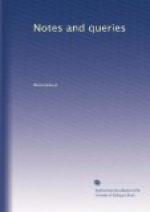(15.) Is it owing to the extreme rarity of copies of the first edition of the Pagninian version of the Scriptures that so many writers are perplexed and ignorant concerning it? One might have expected that such a very remarkable impression in all respects would have been so well known to Bishop Walton, that he could not have asserted (Proleg. v.) that it was published in 1523; and the same hallucination is perceptible in the Elenchus Scriptorum by Crowe (p. 4.) It is certain that Pope Leo X. directed that Pagnini’s translation should be printed at his expense (Roscoe, ii. 282.), and the Diploma of Adrian VI. is dated “die, xj. Maij. M.D.XXIII.,” but the labours of the eminent Dominican were not put forth until the 29th of January, 1527. This is the date in the colophon; and though “1528” is obvious on the title-page, the apparent variation may be accounted for by remembering the several ways of marking the commencement of the year. (Le Long, by Masch, ii. 475.; Chronol. of Hist., by Sir H. Nicolas, p. 40.) Chevillier informs us (Orig. de l’Imp. p. 143.) that the earliest Latin Bible, in which he had seen the verses distinguished by ciphers, was that of Robert Stephens in 1557. Clement (Biblioth. iv. 147.) takes notice of an impression issued two years previously; and these bibliographers have been followed by Greswell (Paris. G. P. i. 342. 390.). Were they all unacquainted with the antecedent exertions of Sante Pagnini (See Pettigrew’s Bibl. Sussex. p. 388.)
(16.) Why should Panzer have thought that the true date of the editio princeps of Gregorius Turonensis and Ado Viennensis, comprised in the same small folio volume, was 1516? (Greswell, i. 35.) If he had said 1522, he might have had the assistance of a misprint in the colophon, in which “M.D.XXII.” was inserted instead of M.D.XII.; but the royal privilege for the book is dated, “le douziesme iour de mars lan milcinqcens et onze,” and the dedication of the works by Badius to Guil. Parvus ends with “Ad. XII Kalendas Decemb. Anni huius M.D.XII.”
(17.) Who was the author of Peniteas cito? And is it not evident that the impression at Cologne by Martinus de Werdena, in 1511, is considerably later than that which is adorned on the title-page with a different woodcut, and which exhibits the following words proceeding from the teacher: “Accipies tanti doctoris dogmata sancta?”




